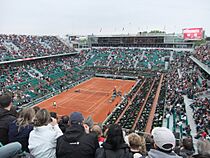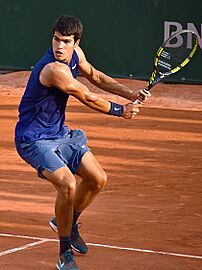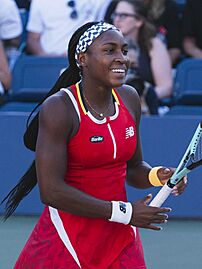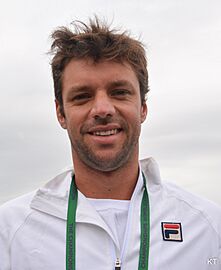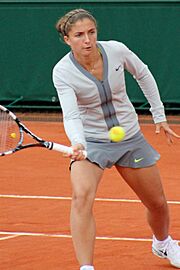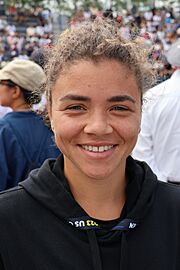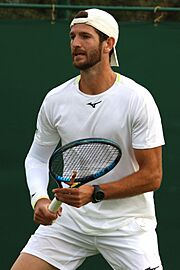French Open facts for kids
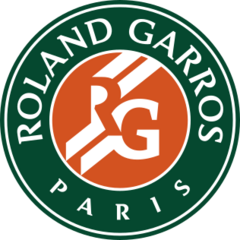 |
|
| Official website: http://rolandgarros.com | |
| Founded | 1891 |
|---|---|
| Editions | 124 (2025) 95 Grand Slam events (since 1925) |
| Location | Paris France |
| Venue | Stade Roland Garros (since 1928) |
| Surface | Clay – outdoors (1908–present) Sand – outdoors (1892–1907) Grass – outdoors (1891) |
| Prize money | €56,352,000 (2025) |
| Men's | |
| Draw | S (128Q) / 64D (16Q) |
| Current champions | Carlos Alcaraz (singles) Marcel Granollers Horacio Zeballos (doubles) |
| Most singles titles | Rafael Nadal (14) |
| Most doubles titles | Roy Emerson (6) |
| Women's | |
| Draw | S (128Q) / 64D (16Q) |
| Current champions | Coco Gauff (singles) Sara Errani Jasmine Paolini (doubles) |
| Most singles titles | Chris Evert (7) |
| Most doubles titles | Martina Navratilova (7) |
| Mixed doubles | |
| Draw | 32 |
| Current champions | Sara Errani Andrea Vavassori |
| Most titles (male) | Ken Fletcher / Jean-Claude Barclay (3) |
| Most titles (female) | Margaret Court (4) |
| Grand Slam | |
|
|
| Last completed | |
| 2025 French Open | |
The French Open, also known as Roland-Garros, is a famous tennis tournament. It is held every year in Paris, France, at the Stade Roland Garros. This exciting event is organized by the French Tennis Federation.
Roland-Garros is one of the four biggest tennis tournaments in the world. These are called Grand Slams. It happens after the Australian Open and before Wimbledon and the US Open. The tournament started way back in 1891. It became a Grand Slam event in 1925.
The French Open usually starts in late May and lasts for two weeks. The tournament and its stadium are named after a brave French pilot, Roland Garros.
This tournament is special because it's the most important clay court championship. It's the only Grand Slam played on a clay surface. Clay courts make the ball bounce higher and slow down the game. This makes matches very challenging. Many players consider it the most physically demanding tennis tournament.
Contents
History of Roland-Garros
The official French name for the tournament is Internationaux de France de Tennis. However, most people around the world call it Roland-Garros or the French Open.
How the Tournament Started
The tournament began in 1891 as the Championnat de France. At first, only tennis players from French clubs could join. The first winner was H. Briggs, a British player living in Paris. In 1897, women's singles matches were added. Mixed doubles started in 1902, and women's doubles in 1907. The tournament was paused during World War I from 1915 to 1919.
In 1925, the French Championships opened up to amateur players from all over the world. This made it a major international event. It was played on clay courts at different locations.
Moving to Stade Roland Garros
In 1927, a group of French tennis players, known as "The Four Musketeers", won the Davis Cup. To defend their title in 1928, France built a brand new tennis stadium. This stadium was named Stade Roland Garros after the famous aviator. The French International Championships moved to this new stadium on May 24, 1928. It has been held there ever since. The main court there is now called Court Philippe Chatrier.
Modern Changes and Equal Prizes
In 1968, the French Championships made history. It became the first Grand Slam to allow both amateur and professional players to compete. This was known as the "Open Era."
Since 1981, special awards have been given out. These include the Prix Orange for good sportsmanship and the Prix Citron for strong personality. Since 2006, the tournament has started on a Sunday. This adds more matches for fans to enjoy. In 2007, a big change happened: men and women started receiving equal prize money in all rounds.
The 2022 tournament introduced a new tiebreaker rule. If a deciding set is tied at six games all, players now play a 10-point tiebreaker. This change was made to make rules more consistent across all Grand Slams. The 2024 tournament was special because it was the first time since 2004 that none of the "Big Three" (Roger Federer, Rafael Nadal, and Novak Djokovic) were in the men's final.
Stadium Upgrades
Over the years, the Roland-Garros stadium has been updated. From 2004 to 2008, there were talks about building a roof to prevent rain delays. In 2011, it was decided to keep the tournament at its current location and expand it.
The expansion project included building a retractable roof over Court Philippe-Chatrier. A new 5,000-seat court, Court Simonne-Mathieu, was also built. This new court is special because it's surrounded by beautiful greenhouses.
Renovation work finished around 2019. The new roof on Court Philippe-Chatrier was used for the first time in the 2020 tournament. That year, the tournament was held later than usual, in September and October, due to the COVID-19 pandemic. Night matches also became possible thanks to new floodlights on all courts. The tournament returned to its usual May-June schedule in 2021.
Unique Clay Courts
The French Open is the only major tennis tournament played on clay courts. This has been the case since 1978. Clay courts are different from grass courts or hard courts. They make the ball slow down and bounce higher.
This unique surface changes how players play. It makes it harder for players who rely on powerful serves. Instead, it favors players who are good at long rallies and moving around the court. For example, Pete Sampras, who won many Grand Slams, never won the French Open. His best result was reaching the semi-finals in 1996.
On the other hand, players like Rafael Nadal, Björn Borg, and Chris Evert have had amazing success here. Their playing styles are perfect for clay courts. Winning both the French Open (on clay) and Wimbledon (on grass) is very difficult. Only a few male players, like Rod Laver and Novak Djokovic, have achieved this in the Open Era.
What are the courts made of?
The clay courts at Roland-Garros are made of several layers:
- Red brick dust on top.
- Crushed white limestone.
- Clinker (a type of coal residue).
- Crushed gravel.
- Drain rock at the very bottom.
Trophies and Prizes
The beautiful trophies given to the winners have been made by a famous Parisian jewelry company, Mellerio dits Meller, since 1953. They are all made of pure silver and have detailed designs. Each singles winner gets their name engraved on the trophy's base. Winners also receive smaller silver copies of their trophies to keep.
The men's singles trophy is called the Coupe des Mousquetaires (The Musketeers' Cup). It honors "Four Musketeers" of French tennis. This trophy is quite large, weighing 14 kg and standing 40 cm tall. The original trophy always stays with the French Tennis Federation.
The women's singles trophy is the Coupe Suzanne Lenglen (Suzanne Lenglen Cup). It was named in 1979 after the legendary French tennis player, Suzanne Lenglen. The current cup is a replica of one she received from the city of Nice. Like the men's trophy, the original stays with the Federation, and winners get a smaller copy.
Prize Money
For the 2025 tournament, the total prize money was €56,352,000. This was an increase from the 2024 tournament.
| Event | Winner | Finalist | Semifinals | Quarterfinals | Round of 16 | Round of 32 | Round of 64 | Round of 128 | Q3 | Q2 | Q1 |
| Singles | €2,550,000 | €1,275,000 | €690,000 | €440,000 | €265,000 | €168,000 | €117,000 | €78,000 | €43,000 | €29,500 | €21,000 |
| Doubles1 | €590,000 | €295,000 | €148,000 | €80,000 | €43,500 | €27,500 | €17,500 | N/A | N/A | N/A | N/A |
| Mixed doubles1 | €122,000 | €61,000 | €31,000 | €17,500 | €10,000 | €5,000 | N/A | N/A | N/A | N/A | N/A |
| Wheelchair singles | €63,900 | €31,950 | €20,600 | €12,360 | €8,750 | N/A | N/A | N/A | N/A | N/A | N/A |
| Wheelchair doubles1 | €21,650 | €11,350 | €8,250 | €5,150 | N/A | N/A | N/A | N/A | N/A | N/A | N/A |
| Quad wheelchair singles | €63,900 | €31,950 | €20,600 | €12,360 | N/A | N/A | N/A | N/A | N/A | N/A | N/A |
| Quad wheelchair doubles1 | €21,650 | €11,350 | €8,250 | N/A | N/A | N/A | N/A | N/A | N/A | N/A |
- 1 Prize money for doubles is per team.
Rankings Points
Players earn points for their world rankings based on how far they go in the tournament. These points are important for their professional careers.
Senior Points
| Event | W | F | SF | QF | Round of 16 | Round of 32 | Round of 64 | Round of 128 | Q | Q3 | Q2 | Q1 |
| Men's singles | 2000 | 1300 | 800 | 400 | 200 | 100 | 50 | 10 | 25 | 16 | 8 | 0 |
|---|---|---|---|---|---|---|---|---|---|---|---|---|
| Men's doubles | 0 | N/A | N/A | N/A | N/A | N/A | ||||||
| Women's singles | 780 | 430 | 240 | 130 | 70 | 10 | 40 | 30 | 20 | 2 | ||
| Women's doubles | 10 | N/A | N/A | N/A | N/A | N/A |
Wheelchair Points
|
Junior Points
|
Champions of Roland-Garros
Past Champions
- Men's singles, winners of the Coupe des Mousquetaires.
- Women's singles, winners of the Coupe Suzanne Lenglen.
- Men's doubles, winners of the Coupe Jacques Brugnon.
- Women's doubles, winners of the Coupe Simone Mathieu.
- Mixed doubles, winners of the Coupe Marcel Bernard.
- See all champions
Current Champions (2025)
These are the winners from the 2025 French Open:
|
Latest Finals (2025)
Here are the results from the most recent finals:
| 2025 event | Champion | Runner-up | Score |
|---|---|---|---|
| Men's singles | 4–6, 6–7(4–7), 6–4, 7–6(7–3), 7–6(10–2) | ||
| Women's singles | 6–7(5–7), 6–2, 6–4 | ||
| Men's doubles | 6–0, 6–7(5–7), 7–5 | ||
| Women's doubles | 6–4, 2–6, 6–1 | ||
| Mixed doubles | 6–4, 6–2 |
Roland-Garros Records
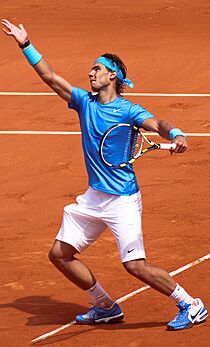
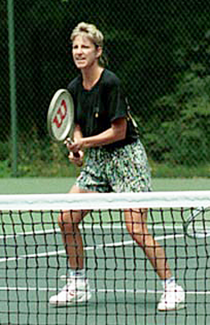
Here are some amazing records from the French Open:
| Record | Era | Player(s) | Count | Years |
|---|---|---|---|---|
| Men since 1891 | ||||
| Most singles titles | Open Era | 14 | 2005–2008, 2010–2014, 2017–2020, 2022 | |
| Amateur Era | 4 | 1926, 1928, 1930, 1932 ● World Hard Court Championships: 1922 |
||
| French Championships* | 8 | 1903–1904, 1907–1909, 1912–1914 | ||
| Most consecutive singles titles | Open Era | 5 | 2010–2014 | |
| Amateur Era | 2 | 1948–1949 1951–1952 1954–1955 1959–1960 |
||
| French Championships* | 4 | 1897–1900 | ||
| Most doubles titles | Open Era | 4 | 2007 with Mark Knowles, 2010 with Nenad Zimonjić, 2011, 2012 with Max Mirnyi. 2005, 2006 with Jonas Björkman, 2011, 2012 with Daniel Nestor. |
|
| Amateur Era | 6 | 1960, 1962 with Neale Fraser, 1961 with Rod Laver, 1963 with Manuel Santana, 1964 with Ken Fletcher, 1965 with Fred Stolle. | ||
| French Championships* | 13 | 1902–1909, 1911–1914, 1920 | ||
| Most consecutive doubles titles | Open Era | 3 | 2010–2012 | |
| Amateur Era | 6 | 1960–1965 | ||
| French Championships* | 10 | 1906–1914, 1920 | ||
| Most mixed doubles titles | Open Era | 3 | 1968, 1971, 1973 with Françoise Dürr. | |
| Amateur Era | 3 | 1963–1965 with Margaret Court. | ||
| French Championships* | 7 | 1904–1906, 1908–1909, 1914 and 1920 with Suzanne Lenglen. | ||
| Most Championships (singles, doubles & mixed doubles) |
Open Era | 14 | 2005–2008, 2010–2014, 2017–2020, 2022 (14 singles) | |
| French Championships* | 28 | 1902–1920 (8 singles, 13 doubles, 7 mixed) | ||
| Women since 1897 | ||||
| Most singles titles | Open Era | 7 | 1974–1975, 1979–1980, 1983, 1985–1986 | |
| French Championships* | 6 | 1920–1923, 1925–1926 ● World Hard Court Championships: 1914, 1921–23 |
||
| Most consecutive singles titles | Open Era | 3 | 1990–1992 2005–2007 2022–2024 |
|
| French Championships* | 4 | 1909–1912 1920–1923 |
||
| Most doubles titles | Open Era | 7 | 1975 with Chris Evert, 1982 with Anne Smith, 1984–1985, 1987, 1988 with Pam Shriver, 1986 with Andrea Temesvári. | |
| French Championships* | 6 | 1933, 1934 with Elizabeth Ryan, 1936–1937, 1938 with Billie Yorke, 1939 with Jadwiga Jędrzejowska. | ||
| Most consecutive doubles titles | Open Era | 5 | 1984–1985, 1987–1988 with Pam Shriver, 1986 with Andrea Temesvári. 1991 with Jana Novotná, 1992–95 with Natasha Zvereva. |
|
| French Championships* | 5 | 1967–1971 | ||
| Most mixed doubles titles | Open Era | 3 | 1968, 1971, 1973 with Jean-Claude Barclay. | |
| French Championships* | 7 | 1914, 1920 with Max Decugis, 1921–1923, 1925, 1926 with Jacques Brugnon. | ||
| Most Championships (singles, doubles & mixed doubles) |
Open Era | 11 | 1974–1988 (2 singles, 7 doubles, 2 mixed) | |
| French Championships* | 15 | 1919–1926 (6 singles, 2 doubles, 7 mixed) | ||
| Wheelchair: singles and doubles since 2007, quads since 2019 | ||||
| Most singles titles | Men | 8 | 2007–2010, 2014, 2015, 2018, 2022 | |
| Women | 6 | 2007–2012 | ||
| Quads | 3 | 2019–2021 | ||
| Most consecutive singles titles | Men | 4 | 2007–2010 | |
| Women | 6 | 2006–2009 | ||
| Quads | 3 | 2019–2021 | ||
| Most doubles titles | Men | 8 | 2007–2011, 2013–2015 | |
| Women | 9 | 2010, 2013, 2015, 2018–2022, 2024 | ||
| Quads | 3 | 2019–2022 | ||
| Most consecutive doubles titles | Men | 5 | 2020–2024 2020–2024 |
|
| Women | 5 | 2018–2022 2018–2022 |
||
| Quads | 3 | 2019–2022 | ||
| Miscellaneous | ||||
| Unseeded champions | Men | 1982 1997 2004 |
||
| Women | 1933 2017 2020 2021 |
|||
| Youngest singles champion | Men | 17 years and 3 months (1989) | ||
| Women | 16 years and 6 months (1990) | |||
| Oldest singles champion | Men | 36 years and 20 days (2023) | ||
| Women | 33 years and 10 months (1958) | |||
- The French Championships (1891–1924) was first only for members of French clubs. In 1925, it welcomed international players. It was later renamed the French Open in 1968 when professional players were allowed to compete.
Watching Roland-Garros
Broadcasting in France
France Télévisions and Amazon Prime Video broadcast the French Open in France. They have the rights until 2027. Prime Video shows all 11 "night sessions" exclusively.
Broadcasting in the United States
NBC started showing the French Open in 1975. Later, Tennis Channel also began broadcasting matches. For 2023 and 2024, NBC moved some of its coverage to its streaming service, Peacock.
For 2025 and beyond, TNT Sports acquired the U.S. broadcast rights. Matches are shown mainly on TNT. TBS and TruTV also provide coverage. All matches are available to stream on Max.
Broadcasting in the United Kingdom
The BBC broadcast French Open finals from 1981 until 2011. From 2012 to 2021, ITV4 showed the tournament in the UK. Eurosport started broadcasting in 1989. As of 2025, TNT Sports holds the exclusive UK broadcast rights.
Broadcasting in India
In India, Sony Pictures Sports Network acquired the broadcast rights for the French Open from 2022 through 2024.
Ball Kids at Roland-Garros
For the 2024 French Open, 280 "ramasseurs de balles" (which means "ball gatherers") were chosen. These are the ball boys and ball girls.
They are usually between 11 and 16 years old. They wear matching Lacoste shirts and shorts. To be chosen, kids must apply and be licensed by the French Tennis Federation. In 2023, about 4,000 kids from France applied! Once selected, they get special training before the tournament starts.
See also
 In Spanish: Torneo de Roland Garros para niños
In Spanish: Torneo de Roland Garros para niños
- Lists of champions
- List of French Open champions (all events)
- List of French Open men's singles champions
- List of French Open women's singles champions
- List of French Open men's doubles champions
- List of French Open women's doubles champions
- List of French Open mixed doubles champions
- List of French Open singles finalists during the Open Era, records and statistics
- Other Grand Slam tournaments


